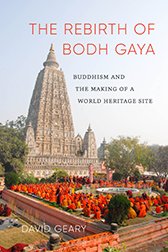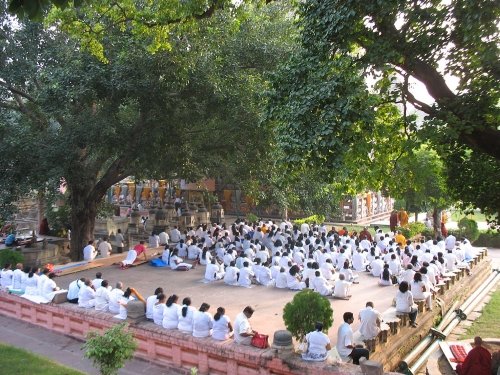I regularly check Amazon.com for new publications on World Heritage, and I found one at the end of last year that sounded interesting:
The Rebirth of Bodh Gaya: Buddhism and the Making of a World Heritage Site
by David Geary. The
Mahabodhi Temple Complex
in Bodh Gaya, centred around the descendant of a Bodhi tree where the Buddha is said to have attained enlightenment, has been a WHS since 2002. The author (an anthropologist) did extensive fieldwork in Bodh Gaya in the years after the designation, and this publication - written with a general audience in mind – reflects his findings.
The complex history of the Mahabodhi Temple

|
The book starts with an interesting deep-dive into the site’s history, after its ‘rediscovery’ in the mid-19th century by state-sponsored Burmese pilgrims. At the time it was already an active Hindu pilgrimage site. There were no Buddhist residents in the area. During the 20th century, Buddhist countries and organizations from abroad started to add monasteries, temples and lodges in their own architectural styles to the area around the main temple. To acknowledge the rise in importance for Buddhists, the site has been under joint Hindu-Buddhist management since 1953. The site got another push after the escape of the 14th Dalai Lama from Tibet to India in 1959. In his footsteps, over 100,000 Tibetan Buddhists moved to India. The Mahabodhi Temple became an important pilgrimage site in their new homeland and the Dalai Lama regularly teaches there.
“Tibetans in exile have lead to the internationalization of Tibetan Buddhism and the revitalization of many Buddhist sites in India.”
The implications of having a WHS in your backyard
Bodh Gaya is located in the state of Bihar, which for long has been regarded as one of the most backward, poor, corrupt and unsafe parts of India. Nowadays it markets itself as ‘Blissful Bihar’, and is actively attracting Western and Asian tourists along its spiritual circuit that also includes
Nalanda
. All developments described above – the foreign-owned monasteries, the Tibetan influx, the state government marketing schemes – largely have disregarded the local population.
The WH designation, with its need for clearly defined core and buffer zones, is seen as another outside influence that impacts their daily life. It served as an alibi for the authorities to push on with their master plan for beautification and “disguise the messiness of everyday”. The locals had to move their shops and have seen a protective wall built to shut them out of the core zone, while foreign Buddhist countries still continue construction in the same area. Geary’s proposed solution is to approach the Mahabodhi Temple Complex as a living religious heritage instead of a museum or archaeological site.

Sri Lankan pilgrims at the site
Readers that are interested in Indian history and current affairs, as well as those curious about the heritage management aspects of a World Heritage designation will surely enjoy this book as much as I did.


